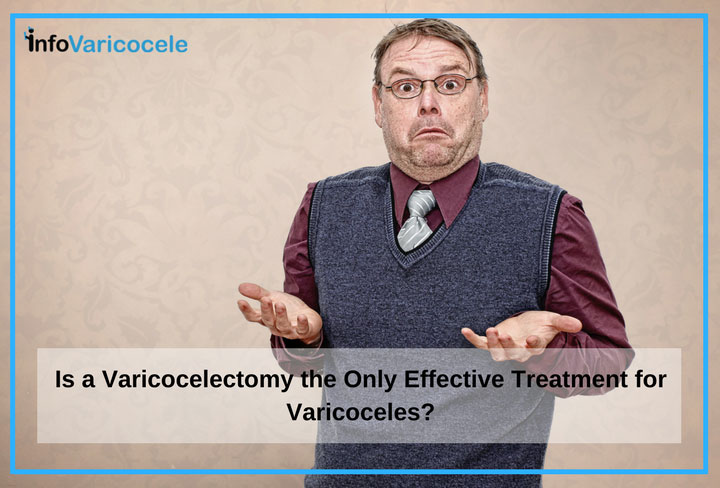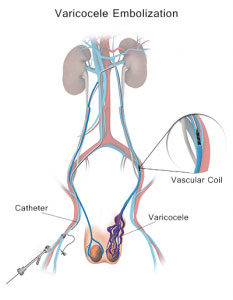
If you have a varicocele, you may be curious about your treatment options. A varicocele is a collection of dilated blood vessels, or veins, around the testicles and scrotum and most often occurs on the left side. It’s estimated that 15% of men have varicoceles and the usual symptoms include testicular pain or discomfort that may be brought on by sitting or standing for long periods of time.[i] Varicoceles are also a known contributor to infertility, or the inability for a couple to get pregnant after 12 months of unprotected intercourse.[ii]
What is a Varicocelectomy?
There are safe, effective treatments for varicoceles. Varicocelectomy is one of the first terms most men come across when they begin to research their treatment options after a varicocele diagnosis. What is a varicocelectomy? Simply put, it’s the surgical treatment of varicoceles. Surgical varicocelectomy procedures involve tying off the veins that supply blood to the varicocele. While it is the first term most people come across it is important to recognize that it is a surgery and that there is also an alternative, non-surgical, treatment option for varicoceles. Varicocele embolization is a minimally invasive procedure performed by an interventional radiologist. Varicocele embolization is an effective way of treating varicoceles without surgery.
While varicoceles are common, they do not always need to be treated. Treatment of a varicocele is generally recommended when certain conditions exist. Standard guidelines for recommending treatment of the varicocele include when the varicocele:
- Can be felt by a physician.
- Is thought to be contributing to male factor infertility and the couple has been unable to get pregnant after 12 months of regular unprotected intercourse.
- Contributes to infertility in cases where the female partner either does not have infertility or has a treatable cause of infertility.
- Is present and abnormal semen has been detected that may be impacting male fertility.[i]
More About the Types and Effectiveness of a Varicocelectomy
Varicocelectomy can be performed using several surgical approaches. Each technique varies in its efficacy and risk of complications. Researchers measure the effectiveness of the procedure based upon the chance that the varicocele will recur, whether there is an improvement in sperm quality and quantity, and the percentage of spontaneous pregnancies that occur after the procedure.
Open Varicocelectomy – Open varicocelectomy is a surgical procedure that involves an incision in the groin, or the inguinal region. The veins that are causing varicoceles are tied off. Because there may be veins that can’t be reached during this approach, the recurrence rate is high, up to 15%.[iii] There is also a higher risk for development of a collection of fluid around the scrotum following the surgery, known as a hydrocele.[ii][i]
Microsurgical Varicocelectomy – Microsurgical varicocelectomy involves an incision in the groin that is similar to the incision used in the open procedure, but a microscope is also used to improve the identification of the blood vessels. This procedure has a lower rate of recurrence, about 1%, and a very low chance of the formation of hydrocele, less than 1%.[iii] This procedure does take more time to perform compared to other techniques.
Laparoscopic Varicocelectomy – The laparoscopic varicocelectomy approach utilizes several small incisions in the abdomen to allow for a scope, (a type of camera) and surgical equipment to visualize, and gain access to the veins that are supplying blood to the varicocele. This approach is associated with a 4.3 – 6.1% chance of recurrence, and the chance of hydrocele formation is 2.84%.[iii] This procedure does require the use of general anesthesia, or being made completely unconscious, which further increases the risk of the procedure.
Consider All Effective Treatment Options Before Deciding on Varicocelectomy
Choosing a treatment option for a varicocele is an individual decision. If you do not feel that surgery is the right choice for you, you may want to consider varicocele embolization.
 Varicocele Embolization – During this procedure, an interventional radiologist will make a nick in the skin and thread a small catheter through this nick and into a vein, usually in the groin. This catheter is then used to place small metal coils, and/or a sclerosing agent into the dilated veins. This results in the malfunctioning veins being blocked from blood flow, which forces the blood flow to be diverted to healthy veins and restores blood flow to the circulatory system. The return of normal blood flow resolves other problems caused by varicocele. Testosterone can be elevated to normal levels and there are increases in sperm quantity and quality, although these outcomes can take 3 – 4 months to achieve. [iii]
Varicocele Embolization – During this procedure, an interventional radiologist will make a nick in the skin and thread a small catheter through this nick and into a vein, usually in the groin. This catheter is then used to place small metal coils, and/or a sclerosing agent into the dilated veins. This results in the malfunctioning veins being blocked from blood flow, which forces the blood flow to be diverted to healthy veins and restores blood flow to the circulatory system. The return of normal blood flow resolves other problems caused by varicocele. Testosterone can be elevated to normal levels and there are increases in sperm quantity and quality, although these outcomes can take 3 – 4 months to achieve. [iii]
Effects of Varicocelectomy and Varicocele Embolization on Fertility
You probably already know that infertility is a main indication for the treatment of a varicocele. Varicoceles can lead to diminished production and health of the sperm. Varicocelectomy and varicocele embolization can lead to an increase in the sperm count and improved quality of the sperm.[i] Because there are so many factors involved in getting pregnant, this does not always mean that the chances of getting pregnant improve. The pregnancy rate after each type of procedure is:
- Open Varicocelectomy – 33 – 37%
- Laparoscopic Varicocelectomy – up to 40%
- Microsurgical Varicocelectomy – up to 50%[iii]
- Varicocele Embolization – The pregnancy rate after a varicocele embolization is comparable to the pregnancy rates after a varicocele surgery.
If you’re interested in this minimally invasive treatment option, an interventional radiologist can help determine if varicocele embolization is a viable option for treatment of your varicocele.
Sources:
[i] Choi, W., and Kim, S., Current Issues in Varicocele Management: A Review. World J Mens Health, 2013. 31(1): p. 12-20.
[ii] American Pregnancy Association. Male Infertility: Causes, Treatment and Prevention. http://americanpregnancy.org/infertility/male-infertility
[iii] Kupis, L., Dobronski, P.A., Radziszewski, P., Varicocele as a source of male infertility – current treatment techniques. Cent European J Urol, 2015. 68: p. 365-370.
[iv] http://www.ncbi.nlm.nih.gov/pubmed/18375298


